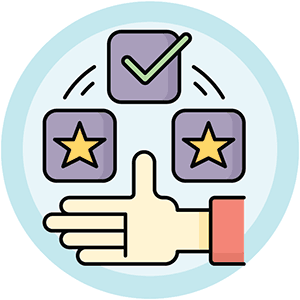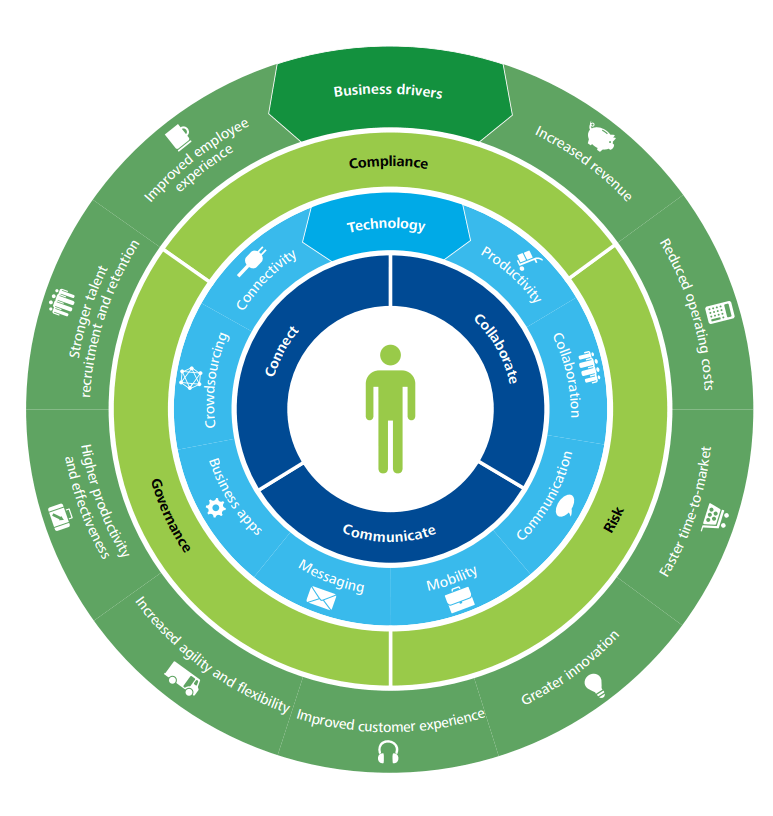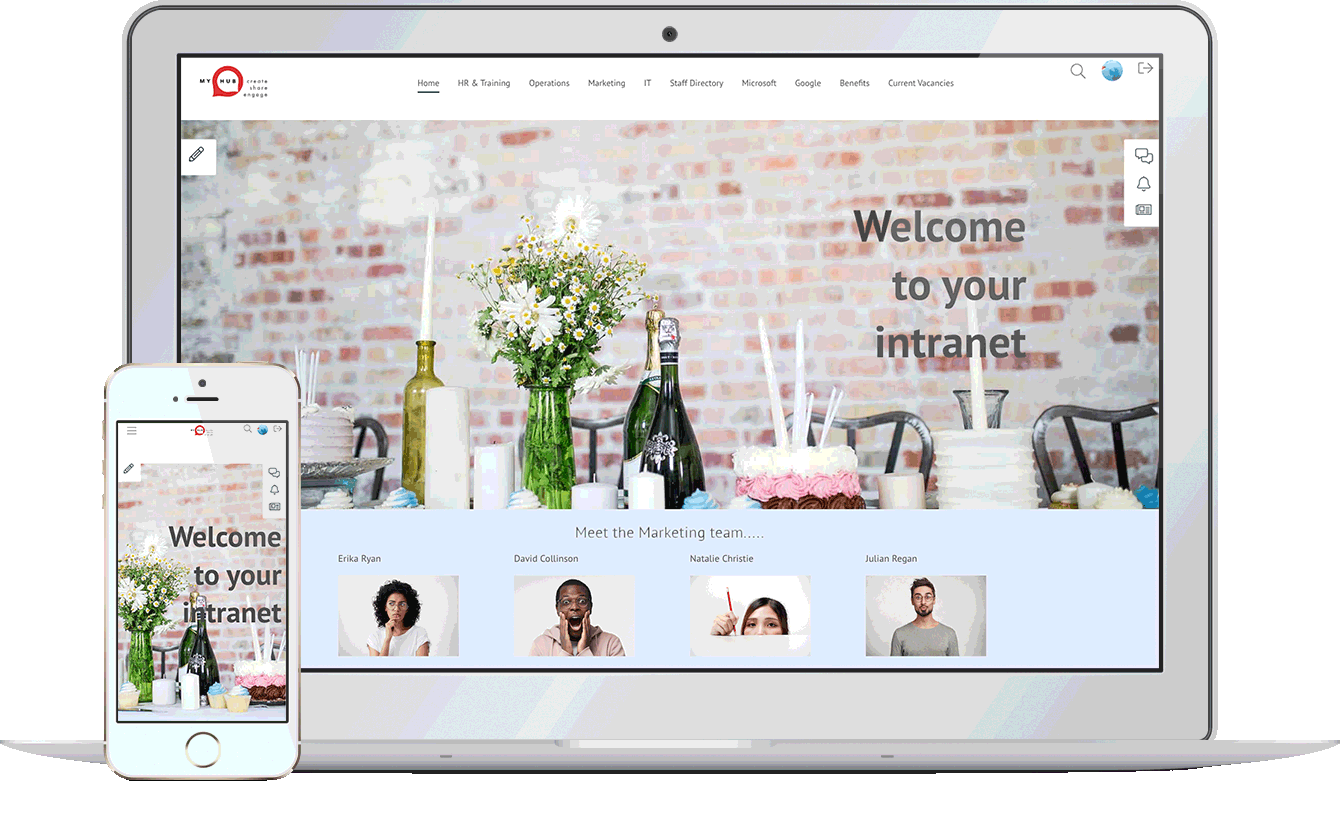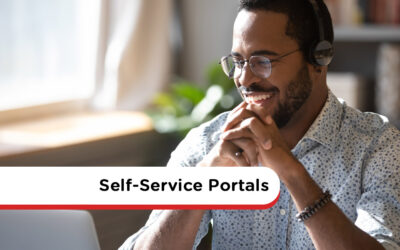Digital Workplace
Enable remote working for staff and let technology, people and processes unite
Share. Engage. Connect

Today’s always-connected, instant-access working environment has questioned the need for office-based working. Like never before, staff are connecting and collaborating with their peers in real-time, from any location.
As more staff transition to a work-from-home scenario, digital workplace technology offers a vital agile setting for businesses. Digital workplace technology can improve productivity, creative thinking, and team collaboration.
While some organizations have already embraced a digital workplace culture, others are being forced unexpectedly into managing staff remotely. The silver lining for the latter cohort is that if done right, remote working can facilitate a smarter, faster, better operation. Businesses stand to benefit from increased employee engagement and all-round improved business performance.
What is the Digital Workplace?

One of the most accepted definitions of the digital workplace is “the alignment of technology, employees and business processes to improve operational efficiency and meet organizational goals”.
Gartner describes it as a way of enabling new, more effective ways of working; raising employee engagement and agility; and exploiting consumer-oriented styles and technologies.
It’s been dubbed as the fourth industrial revolution, the digital transformation.
New digital workplace practices are being embedded into everyday life, across every size and type of business. Artificial intelligence, automation, and machine learning technology are taking over manufacturing, service work, and many other essential business tasks. And while most companies acknowledge the benefits of digital working, many admit to lacking the technical knowledge to lead the way (source: McKinsey & Company).
Distributed Working: The New Normal

The way in which we spark ideas and get work done has changed forever. With more employers supporting the distributed workforce model – either through choice or an unexpected crisis – the practical side of completing tasks and communicating with colleagues now, more-often-than-not, takes place in a digital space. Indeed, many economists forecast the physical office will soon be a thing of the past, accelerated by the recent Covid-19 pandemic.
A distributed workforce – also known as remote workers, digital nomads, telecommuters or home office workers – work from any location, across multiple devices. They value work/life balance, flexible hours – and critically, the need to feel connected. Digital workplace technology provides this essential connection – emphasizing the importance of friction-free, easy-to-use software.
If the physical office is no longer a place we go to work, these digital touchpoints play a vital role in how employees stay motivated, informed and engaged in what they do.
The onus will be on the employer to optimize the digital workplace experience for employees. Security, fast access, as well as intuitive and compatible software are just some of the important considerations when transitioning into a digital world.
Key Benefits Of A Digital Workplace Strategy
The advantages of adopting a digital workplace strategy spread wider than most businesses originally anticipate. Here are some of the expected and unexpected benefits:
Team Collaboration
Improved levels of problem-solving, interaction and knowledge-sharing – all-round improved collaboration
Flexible Remote Working
Allows employees to work from home, supporting more flexible working
Productivity Boost
Increased efficiency and employee productivity through improved communications
Innovation
Great ideas can come from anywhere – not just the boardroom – if staff have the right channels
Change Management
Clear, reliable communications minimizes confusion and garners internal support
Improved Transparency
Improved traceability and transparency amongst teams, reducing errors
Hidden Savings
Decreased employee commuting expenses and business real estate cost
Employee Experience
Improved personal experiences through greater inclusivity and integration of tasks
Retain Talent
Lower employer turnover rates due to improved work/life balance and engagement
The Digital Workplace Framework
Deloitte has developed a four-layer framework to help govern the design of a digital workplace. This is a useful guide for those businesses looking for workplace transformation. This framework comprises of:
1) Use – for staff to collaborate, communicate and connect
2) Technology – the digital tools to enable staff to do their job
3) Control – having the right governance structure and compliance controls in place to reduce risk
4) Business drivers – measuring the outcomes and actual business value.
It explains how to leverage your investment to support a new and better way of doing business that will enhance both the employee experience and the customer experience.

Tips For Deploying A Digital Workplace
Here are some practical tips to help you blend your existing applications with new technology to create the ultimate user experience and a high-performing work environment.
1. Involve the right people to steer the project. Senior ownership is vital, but including representatives who will drive the technology is also key.
2. Ensure alignment with business strategy. Keep your big picture always in mind i.e. ‘will this new tool and process-change enable us to achieve our goals?’
3. Consider internal culture. How amenable will staff be to new technology and digital experiences? Develop an internal communications program to explain the benefits of digital technology and how vital it is in today’s workplace. And most of all, make it easy for staff to do their job.
4. Deliver business value. Avoid falling for the ‘shiny new thing’. Stay true to the original outcomes your business needs.
5. Research technologies. A good case study, a free trial, a call with a current user – these are all helpful ways to shortlist new technologies. There are multiple service providers playing in a very dynamic, competitive digital market.
6. Consider risk, compliance and legal consequences. There are important regulations surrounding data management and security that must be adhered.
Digital Workplace: Future Trends
What are the anticipated trends at play when today’s graduates become tomorrow’s C-suite, artificial intelligence is mainstream, and the traditional office is no more?
Here’s our view of the future and the role of the digital workplace:
Cloud-based Solutions
Effective, cloud services with unlimited access will be essential to support remote working
No Standing Still
Technology will continue to evolve, either organically or intentionally. Status quo is not an option
All-On Automation
Traditional ways of working will continue to be disrupted; automated processes will increase
Tech Choice Matters
Technology stack choices will become more important when attracting staff and tech compatibility
Staff Expectations
Young workers have a huge appetite for social tools and tech, increasing pressure for employers to invest
Customer Self-Service
Customers will want to search and solve their own questions independently, without speaking with an agent
Overwhelming Options
Choice-explosion of SaaS products could be overwhelming; apps may fail to work together
Employee Experience
Employers will try harder to motivate, engage, inspire and involve staff to retain talent
Tech Maze
Employees become ‘trapped in the tech maze’ with many apps overlapping and staff feeling bamboozled
❝
The Digital Workplace is a work in progress, an ongoing journey, with only 14% of companies believing they are at a ‘mature phase’.
Source: Digital Workplace Group
Digital Workplace Software
Core to the successful adoption of a digital attitude is finding ways to support staff as they navigate through the tech maze of the modern digital workplace, along with adjusting to working from home. While there are countless business apps and platforms suited to their specific areas of business, a central hub – or gateway if you like – where staff can access everything they need to complete their job is vital.
MyHub intranet software provides that central digital space for staff to communicate, share and source company information, regardless of their location. Our cloud-hosted, single access point makes life easier for staff, helping them do their job better.
From instant messaging to the seamless integration of business applications, workflow automation to access-controlled content libraries, MyHub brings together all this into a beautifully-sleek, easy-to-navigate digital workplace. All accessible with a single sign-on.
Digital Workplace Tools: The MyHub Difference

Considered the central hub of your digital workplace solution, MyHub is fully scalable, designed to support your company’s growth. And fully customizable, to meet your exact needs.
Designed with the non-technical buyer in mind, MyHub requires no coding skills or IT experience. It is simple to set-up – and fun to use!
Using simple drag-and-drop functionality, you can create a professional digital workspace in minutes! Being cloud-hosted also means you’re future-proofing your investment: you get to benefit from our latest new features and enhancements as soon as they’re released.
Let our technology unleash a smarter and super-efficient digital workplace solution that your staff will love.
❝
Managers have reduced the time spent on management activities by one to three hours due to system integration and collaboration tools
Useful Digital Workplace Resources
Intranet Surveys: How To Get Started
Intranet surveys are an effective and affordable way for companies to boost employee engagement, measure satisfaction, and direct strategic growth. This comprehensive guide outlines how organizations can use internal surveys to collect actionable feedback from staff, build trust, and foster a culture of open communication. By doing so, businesses can ensure they’re aligned with employee needs while also improving productivity and retention.
The post covers best practices for designing impactful surveys, including optimal question types, ideal survey length, and how to balance qualitative and quantitative feedback. It explores key survey categories such as company culture, workplace environment, recognition, personal development, and internal relationships. The article also provides dozens of sample questions to help HR teams or internal communicators get started quickly.
Finally, the blog emphasizes the importance of follow-through. Gathering data is only useful if companies act on the insights. Publishing results, implementing changes (both quick wins and long-term fixes), and communicating progress are critical for success. When done right, Intranet surveys become a vital tool for continuous improvement and employee engagement.
CEO Blog: Mastering Communication with Staff and Clients
In today’s fast-paced business environment, effective communication from leadership is more crucial than ever. A CEO blog provides a powerful internal communication tool that connects employees directly with top leadership. By regularly publishing transparent and engaging content, CEOs can bridge gaps in understanding, strengthen trust, and cultivate a sense of inclusion across all levels of the organization.
Beyond simple messaging, a CEO blog also plays a vital role in reinforcing company values and culture. It creates a platform to celebrate achievements, explain strategic changes, and align the team with business objectives. With the added ability to invite two-way conversations via comments or polls, it becomes a dynamic channel that promotes openness and fosters collaboration.
To ensure long-term success, CEOs should focus on authenticity, consistency, and accessibility. Whether you’re sharing personal reflections or important company updates, an authentic voice resonates more deeply with staff and clients alike. Hosting your blog on the company intranet ensures easy access, while short, regular posts keep engagement high. The result? Stronger leadership presence, a more connected team, and a thriving organizational culture.
Employee Motivation Uncovered: Discover What Inspires Your Team
In today’s business landscape, employee motivation is more than a feel-good concept—it’s a vital strategy for improving productivity, engagement, and overall company performance. This blog post explores why understanding what drives your team is essential and debunks the myth that money is the only motivator. Instead, it emphasizes how recognition, purpose, and autonomy play a central role in unlocking potential.
The article breaks motivation down into a practical framework: Recognition, Responsibility, Growth, and Rewards. It offers actionable strategies for each element, including implementing low-cost recognition programs, empowering employees through decision-making, and using intranet tools to support learning and innovation. Real-life data and studies from Gallup and McKinsey reinforce the impact of these approaches on performance and profitability.
Finally, the blog shows how companies can scale these efforts using modern tools like company intranets. From launching employee-driven idea hubs to fostering a culture of continuous improvement, the post provides a roadmap for any organization looking to invest in employee motivation as a strategic differentiator.
8 Top Performance Review Tips For Managers
Performance reviews are an essential part of managerial duties, but many managers struggle to make them meaningful and productive. In this blog post, we explore eight top performance review tips that help managers conduct effective evaluations. From shifting your perspective from judge to coach, to preparing thoroughly for each meeting, the article emphasizes the importance of clear communication and ongoing feedback throughout the year. The tips aim to enhance both the employee’s experience and the manager’s effectiveness.
Key strategies highlighted include gathering 360-degree feedback, creating a comfortable and distraction-free environment, and delivering balanced feedback that acknowledges achievements while addressing areas for growth. Managers are also encouraged to share review materials in advance, set clear goals during the meeting, and schedule regular follow-ups to track progress. These actions help create a transparent, collaborative process that benefits both the employee and the organization.
Ultimately, the goal of performance reviews is not just to evaluate performance but to foster growth and motivation. By implementing these tips, managers can ensure that reviews are not a dreaded task but an opportunity for development and mutual success. Incorporating regular check-ins and setting achievable goals ensures continuous improvement, leading to higher engagement and retention within teams.
Mindfulness In The Workplace: Practical Ways To Introduce It
Mindfulness in the workplace is gaining popularity, with major companies like Google and Nike adopting mindfulness practices to boost employee well-being and productivity. At its core, mindfulness means staying present and focused, avoiding distractions from past or future concerns. This approach helps employees concentrate on the task at hand, reduce stress, and enhance overall performance. The concept stems from Buddhist teachings but has evolved into a powerful tool for modern professionals.
The benefits of mindfulness in the workplace are wide-ranging. It builds resilience, strengthens emotional intelligence, boosts creativity, and enhances personal relationships between colleagues. Employees who practice mindfulness are better able to manage stress and improve focus, leading to better work quality and healthier work dynamics. Mindfulness encourages an empathetic, innovative, and resilient workforce, improving both individual and team performance.
To successfully introduce mindfulness in the workplace, employers should start by incorporating small, manageable practices. Simple exercises like mindful breathing or offering a quiet space for meditation can make a big difference. Ensuring that mindfulness is optional and not mandatory is key to its success, as forcing participation can lead to resistance. By creating a supportive environment for mindfulness, businesses can foster a more balanced and productive workforce.
Employee Self-Service Portals: More Than Just A HR Resource
Employee self-service portals (ESS) have evolved beyond basic HR functions to become essential tools that streamline business processes and empower employees. Initially used for accessing HR records and payroll, these portals now support a range of operational tasks such as managing expenses, tracking professional development, and facilitating remote work. With a user-friendly interface and 24/7 accessibility, ESS portals not only enhance productivity but also improve employee satisfaction and morale.
The versatility of these portals extends to various multimedia formats, including how-to videos, webinars, and FAQs, making information more accessible and engaging. They also simplify everyday business operations like submitting holiday requests or professional development forms, reducing administrative overhead. These features free up HR staff to focus on more strategic tasks while ensuring employees can independently manage routine processes.
Beyond HR, ESS portals are especially beneficial in onboarding new employees. By providing a centralized hub with tailored resources, new hires can quickly access relevant information and complete necessary tasks. This leads to a smoother integration into the company, accelerating productivity from day one. ESS portals are not only cost-effective for small businesses but also scale seamlessly as companies grow, ensuring they remain a valuable resource for businesses of all sizes.






